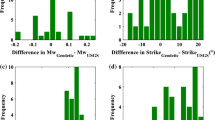Abstract
A novel hybrid approach to earthquake location is proposed which uses a combined coarse global search and fine local inversion with a minimum search routine. The method exploits the advantages of network ray tracing and robust formulation of the Fréchet derivatives to simultaneously update all sampled initial source parameters in the solution space to determine the best solution. Synthetic examples, involving a three-dimensional (3-D) complex velocity model and a challenging source–receiver layout, are used to demonstrate the advantages over direct grid search algorithms in terms of solution accuracy, computational efficiency, and sensitivity to noise. Therefore, this is a promising scheme for earthquake early warning, tsunami early warning, rapid hazard assessment, and emergency response after strong earthquake occurrence.






Similar content being viewed by others
References
Bai, C.-Y. and Greenhalgh, S. A. (2006), 3-D local earthquake hypocenter determination with an ‘irregular’ shortest-path method, Bull. Seism. Soc. Am., 96, 2257–2268.
Bai, C.-Y., Greenhalgh, S. A. and Zhou, B. (2007), 3-D ray tracing using a modified shortest-path method, Geophysics, 72, T27–T36.
Bai C.-Y., Tang X.-P. and Zhao R. (2009), 2D/3D multiply transmitted, converted and reflected arrivals in complex layered media with the modified shortest path method, Geophys. J. Int. 179, 201–214.
Fallat M. and Dosso S. (1999), Geoacoustic inversion via local, global, and hybrid algorithms, Acoustical Soc. Am. 105, 3219–3230.
Hartzell S. and Liu P. (1996), Calculation of earthquake rupture histories using a hybrid global search algorithm: applied to the 1992 Landers earthquake, California, Phys. Earth Planet. Inter., 95, 79–99.
Hartzell S. and Liu P. (1995), Determination of earthquake source parameters using a hybrid global search algorithm, Bull. Seism. Soc. Am., 85, 516–524.
Kennett B. L. N. and Sambridge M. S. (1992), Earthquake location: genetic algorithms for teleseisms, Phys. Earth. Planet Int., 75, 103–110.
Klein F. W. (1978), Hypocenter location program—HYPOINVERSE: user’s guide to version 1, 2, 3 and 4, US Geol. Surv. Open File Report., 78-694, 1–113.
Klein F. W. (1988), User’s guide to HYPOINVERSE, a program for VAX computers to solve for earthquake location, US Geol. Surv. Open File Rep., 88.
Lee, W. H. K. and Lahr, J. C. (1975), HYPO71 (revised): a computer program for determining hypocenter, magnitude, and first-motion pattern of local earthquakes, US Geol. Surv. Open File Report, 75-311, 1–116.
Lepage G. P. (1978), A new algorithm for adaptive multi-dimensional integration, J. Comput. Phys. 27:192–203.
Lienert B. R., Berg E. and Frazer L. N. (1986), Hypocenter: An earthquake location method using centered, scaled, and adaptively damped least squares, Bull. Seism. Soc. Am. 76, 771–783.
Lomax A. and Curtis A. (2001), Fast, probabilistic earthquake location in 3D models using oct-tree importance sampling, Geophys. Res. Abstr. 3,955. (http://www.alomax.net/nlloc/octtree).
Mosegaard K. and Tarantola A. (1995), Monte Carlo sampling of solutions to inverse problems, J. Geophys. Res. 100, 12431–12447.
Moser, T. J. (1991), Shortest path calculation of seismic rays, Geophysics, 56, 59–67.
Nelson G. D. and Vidale J. E. (1990), Earthquake location by 3-D finite difference travel times, Bull. Seism. Soc. Am. 80, 395–410.
Pavlis, G., Vernon F, Harvey D. and Quinlan D. (2004), The generalized earthquake location (GENLOC) package: A modern earthquake location library, Comp. Geosci. 30, 1079–1091.
Rawlinson N. and Sambridge M. (2004), Multiple reflection and transition phases in complex layered media using the multistage fast marching method, Geophysics, 69, 1338–1350.
Sambridge M. (1999a), Geophysical inversion with a Neighbourhood algorithm, I, Searching a parameter space, Geophys. J. Int. 138:479–494.
Sambridge M. (1999b), Geophysical inversion with a neighbourhood algorithm, II, Appraising the ensemble, Geophys. J. Int 138:727–746.
Sambridge M. and Kennett, B. L. N. (2001), Seismic event location: nonlinear inversion using a neighbourhood algorithm, Pure. Appl. Geophys 158, 241–257.
Sambridge M. and Mosegaard K. (2002), Monte Carlo methods in geophysical inverse problems, Rev. Geophys 40. doi:10.1029/2000RG000089.
Tang X.-P. and Bai C.-Y. (2009), Multiple ray tracing within 3D layered media with the shortest path method, Chinese. J. Geophys., 52, 1130–1138.
Tarantola A., Inverse problem theory: Methods for data fitting and model parameter estimation (Elsevier, Amsterdam 1987).
Thurber C. H and Rabinowitz N., Advances in Seismic Event Location (Kluwer, Amsterdam 2000).
Thurber, C. H. (1985), Non-linear earthquake location: theory and examples, Bull. Seism. Soc. Am. 78, 2062–2076.
Vidale J. E. (1988), Finite-difference calculation of travel times, Bull. Seism. Soc. Am 78, 2062–2076.
Vidale J. E. (1990), Finite-difference calculation of travel time in three dimensions, Geophysics, 55, 521–526.
Waldhauser F. and Ellsworth W. L. (2000), Double-difference earthquake location algorithm: method and application to the northern Hayward fault, California, Bull. Seism. Soc. Am. 90, 1353–1368.
Zhou B., Sinadinovski C. and Greenhalgh S. A. (1992), Non-linear inversion travel time tomography: imaging high contrast inhomogeneities, Explor. Geophys. 23, 459–469.
Acknowledgments
This research work was funded by the National Natural Science Foundation of China (NSFC, project number: 40534021 and 40774020). We thank Prof. Gary Pavlis of Indiana University, whose comments improve the manuscript substantially.
Author information
Authors and Affiliations
Corresponding author
Rights and permissions
About this article
Cite this article
Bai, Cy., Zhao, R. & Greenhalgh, S. Rapid 3-D Earthquake Location using a Hybrid Global–Local Inversion Approach. Pure Appl. Geophys. 167, 1377–1387 (2010). https://doi.org/10.1007/s00024-010-0102-4
Received:
Revised:
Accepted:
Published:
Issue Date:
DOI: https://doi.org/10.1007/s00024-010-0102-4




